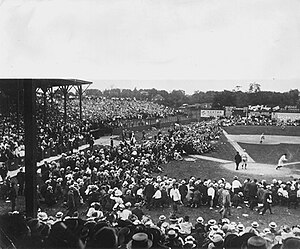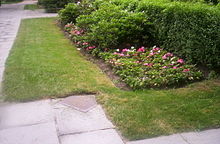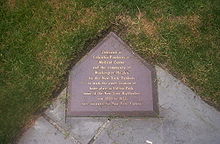Hilltop Park
This "Highland" connection contrasted with their intra-city rivals, the Giants, whose Polo Grounds was just a few blocks away, in the bottomland under Coogan's Bluff.
[2] Both the park and the nickname "Highlanders" were abandoned when the American Leaguers left, at the beginning of the 1913 season, to rent the Polo Grounds from the Giants.
[7] The left field foul line ran mostly North to South and was parallel to Fort Washington Road (the western boundary of the park).
The original 1903 construction of Hilltop Park cost about $200,000, more than two-thirds of which was spent for rock blasting and excavations; and the groundskeeper of the Highlanders, Phil Schenck, laid out the playing field.
Prior to the 1904 season, it was reported, "the rather deep hollow at right field has been nearly obliterated, which will increase the playing space of that portion of the park many feet.
"[9] After the Polo Grounds burnt down in 1911, the Highlanders/Yankees offered to share their facility with the New York Giants, and the grateful National Leaguers took up temporary residence in Hilltop Park.
The Highlanders added a bleacher section in deep center field, painted black to serve as a batter's eye screen.
After two more seasons, the lease expired and the American Leaguers moved a few blocks east and south into the rebuilt Polo Grounds to sub-lease from the Giants.
Although the Yankees were done at the Hilltop, other events were staged there in the fall of 1912, including high school football and Auto polo.
With a Boston runner on third, New York pitcher Jack Chesbro threw a spitball that got away and sailed over the catcher's head.
Although the Highlanders failed to win the league title, their unexpected presence in the pennant race ultimately led to the stabilization of the modern World Series.
The Giants were on their way to winning the National League flag, and they announced ahead of time that they had no intention of playing against their cross-town rivals in a post-season World Series.
Although Boston prevailed in the American League race, the Giants stuck with their plan, and no Series was played.
The resulting public outcry spurred the Giants' owner to organize a committee and establish rules for how future Series were to be conducted.
Detroit outfielder Ty Cobb, "The Georgia Peach", made many a mark on the game of baseball, some famous and some infamous.
[11] The plaque was donated to the hospital by the New York Yankees to commemorate the exact location of where home plate rested in Hilltop Park.






